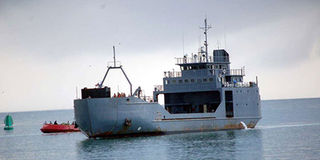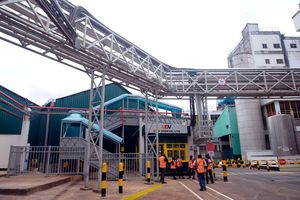Premium
A look into Kenya Navy history ahead of sail-past

Kenya Navy Ship Tana arrives at Mtongwe navy base. The logistics vessels KNS Galana and KNS Tana became operational in 1994. PHOTO | FILE | NATION MEDIA GROUP
What you need to know:
- The 86 Squadron was used in the beach landing operation at Kismayu where the squadron ferried soldiers to the combat zone.
- The majesty of KNS Harambee II will be countered with KNS Jasiri, the 85-metre-long warship, which is the largest vessel in the Kenyan Navy fleet and its flagship ship.
When Kenya decided to enter into the territorial land of Somalia in October 2011 following intensified Al-Shabaab attacks, the 370-tonne Kenya Navy vessel - KNS Harambee II - was to become the first unit to cross over into Somalia as part of the Operation Linda Nchi.
This time, its mission beyond the waters of Kenya was successful, unlike its troubled maiden voyage from France in 2011 that was characterised by loss of power after its battery charging system failed, and failure to communicate with the Kenya Navy headquarters due to incompatibility of radios.
Further, it drifted for 18 hours as engineers on board fought for its survival and their own.
During this year’s Mashujaa Day celebrations, which will be held in the coastal town of Mombasa, the first national holiday to be held in the coast region since independence, KNS Harambee II will participate in a rare fete - the country’s inaugural sail-past.
In the sail-past, which will be a break from the usual Airmen flypasts, the Kenya Navy will display its equipment - including ships, missiles and guns, much of which the public has never seen before.
NAVY'S ROLES
It will not only be a national celebration but also a sail-past highlighting Kenya’s ability to strike from the sea - especially in its increasing tension with the neighbouring Somalia over disputes touching on territorial waters.
Whether the decision to celebrate the national holiday at the coast was arrived at so as to also parade the navy’s prowess before Kenya’s perceived and real enemies will arguably be a subject of further discussion.
This article is based on interviews carried out with military personnel and on information available in the book Kenya Navy: A 50 Year Voyage.
The Navy is tasked with defending Kenya's territorial integrity from external aggressors.
Secondary roles include protection of merchant ships from piracy, combating drug and human trafficking and delivering relief to stricken Kenyans in drought and flood situations.
The ship, KNS Harambee II, designed in 1986 to conduct police operations in the French Exclusive Economic Zone (EEZ) before it was handed over to the Kenya Navy on June 7, 2011, will join other Kenya Navy vessels in the historic event.
DECOMMISSIONED
The majesty of KNS Harambee II will be countered with KNS Jasiri, the 85-metre-long warship, which is the largest vessel in the Kenyan Navy fleet and its flagship ship.
The KNS Jasiri was deployed as the vanguard force during the capture of the port city of Kismayu.
The ship was used in the inserting of 100 Special Forces and the Clearance Diving Unit (DCU) to the theatre of operation.
KNS Jasiri also served as the Command Ship (flag ship) and hospital ship during Operation Sledge Hammer.
According to senior military officers, KNS Jasiri exceeded expectations after it managed to stay in the seas for 30 straight days without having to replenish during Operation Sledge Hammer.
Both KNS Harambee II and KNS Jasiri belong to the 76 Squadron. Other members of the 76 Squadron, KNS Harambee and KNS Jamhuri from the 76 Squadron were decommissioned in a solemn ceremony presided over by President Daniel Moi in 2000.
Both KNS Jamhuri and KNS Harambee first came into service in 1976. They were decommissioned after having been in active service for 24 years, a period in which they became increasingly difficult to support in terms of the maintenance of major equipment on board arising from non-availability of spare parts and obsolescence of the same.
Also on display will be the might of the Navy’s 86 Squadron.
FEATURES
The 86 squadron consists of two fast-attack crafts namely: KNS Nyayo, KNS Umoja and two offshore patrol vessels, KNS Shujaa and KNS Shupavu.
The four ships have integrated packages of sensors, weapons and tactical coordination systems that can provide gunfire support to land-based troops and can also engage air units with their medium and short-range weapons.
The vessels can stay at sea for 14 days at high speeds without refuelling.
Three of the four ships were used in bombarding Kismayu town and neutralising the Al Shabaab militants.
The 86 Squadron was also used in the beach landing operation at Kismayu where the squadron ferried soldiers to the combat zone.
The sister ships KNS Nyayo and KNS Umoja first came into service in 1986. KNS Umoja is more famous after it was used in 1989 to test Kenya’s first live Otomat surface-to-surface missile.
Further, the Navy will display offshore patrol vessels, logistics ships and riverine boats. The offshore patrol vessels KNS Shujaa and KNS Shupavu were delivered in 1997.
CIVILIAN USE
In 2001, Regina Musau, then a Captain, set history when she became the first woman in Kenya Navy history when she sailed on a ship. Ms Musau sailed aboard KNs Shujaa, which was conducting a training cruise.
The logistics vessels KNS Galana and KNS Tana entered service in 1994.
They were first built for civilian use but were later taken over by the Navy for logistical support.
Their major undertaking was the assistance to the people of Lamu during the El-Nino rains when all the roads where cut-off by floods.
They have the capacity to transport an infantry company of the army together with all integral vehicles and equipment.
Previously, they have provided sealifts of Kenya Army units from Mombasa to their deployment area in Baragoni, Lamu.
Riverine boats are vessels that operate in littoral and shallow water environments.
OPERATIONS
The navy vessels have been involved in various exercises among them the Shifta campaigns, Operation Exodus, Operation Mamba, Operation Linda Nchi, Operation Sledge Hammer and Operation Linda Rafiki.
During the Shifta war that fuelled by the dream to unite all Somali-occupied territories in the Horn of Africa under one nation, the Navy was used to convey sections of the Army and the GSU from Mombasa to Lamu following heavy rains and extensive floods that made roads impassable.
During the ouster of Somalia President Siad Barre in 1991, the navy was deployed to control the influx of illegal refuges.
This task, codenamed Operation Exodus, was carried out by the decommissioned KNS Simba and KNS Nyayo.
KNS Simba, which came into service in 1966, was the first squadron of patrol crafts.
It was considered a lucky ship as it was the first to be specifically built for the Kenya Navy.
With no collision or grounding, it was decommissioned after a board established that after 32 years of service, it could not be brought to operational state and sea worthiness.
PIRACY
It was also found out that plans to overhaul it would have been too expensive and involving, and they could neither be cost-effective nor economical.
Operation Mamba was launched in 2010 to protect Kenyan waters from pirates and illegal fishing.
It was later on merged with Operation Linda Nchi in 2011, in which for the first time, Kenya’s military entered another country for an armed offensive.
Operation Sledge Hammer, the offensive that led to the fall of Kismayu city, was carried out on September 28, 2012.
It made history as Africa’s first successful beach landing operation.
“Indeed, its entry into Somalia waters was a gamechanger as it did cut off Al-Shabaab's economic base, freedom of movement and resupply lifeline. Piracy was also dealt a big blow, thereby allowing free movement of ships and trade along the entire East African coast," writes retired General Julius Karangi in the book "The Kenya Navy A 50 Year Voyage."
Through Operation Linda Rafiki, the navy secures and protects vessels involved in carrying out scientific search for fuel resources at sea.
The Kenya Navy gets its origin from the Royal Navy Training Team, which was dispatched to help in the Kenyanisation process back in 1964 through training a number of Kenyans.
Among its pioneers was the late Lt Col J C J Kimaro, who was involved in the building of the Navy.





